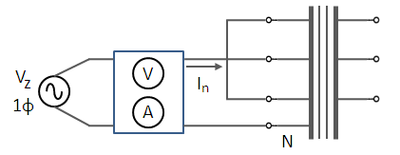Transformer Impedance
Positive Sequence Impedance
The transformer positive sequence impedance is also called the short circuit impedance (because it is measured from a short circuit test) or the impedance voltage (because a voltage is measured from the short circuit test - more details below).
Two Winding Transformer
Impedance Measurement
The positive sequence impedance is measured from a standard short circuit test (see figure right). In this test, one set of windings is shorted (typically the LV windings) and a three-phase voltage source is applied to the other set of windings. The voltage is steadily increased until the rated phase current is measured.
The voltage at this point is called the impedance voltage. When the impedance voltage is expressed as a per-unit value (on the transformer rated line-to-line voltage), the impedance voltage is equivalent to the per-unit impedance, i.e.
where is the measured impedance voltage (V)
- is the rated transformer line-to-line voltage / base voltage (V)
- is the rated transformer current (A)
- is the positive sequence impedance ()
- is the transformer base impedance ()
- is the positive sequence impedance (pu)
The impedance voltage is also often expressed as a percentage (Z%).
Copper Losses
Full load copper (or iron) losses are measured in the same test as the impedance voltage by taking the power reading (from the wattmeter in the test circuit). The copper losses represent the losses from the full load current in the phase windings, as well as stray losses due to induced eddy currents from leakage fluxes in the windings, core clamps, tank and other magnetic pathways.
Calculation of and
The resistive and reactive components of the positive sequence transformer impedance can be estimated from the two short circuit test measurements - 1) impedance voltage, and 2) full load copper losses. The expressions below calculate the resistance and reactance in per-unit quanitities.
Where is the positive sequence resistance (pu)
- is the positive sequence reactance (pu)
- is the positive sequence impedance (pu)
- are the full load copper losses (W)
- is the transformer rated power (kVA)
Application in Transformer Models
The positive sequence impedance measured and calculated above is most often applied in the standard positive sequence two-winding transformer model as representing the transformer leakage impedance. This representation assumes that the parallel magnetising and core loss branch in the T-circuit is a negligible part of the measured positive sequence impedance (note that the magnetising reactance and core losses are estimated separately in no-load (open circuit) tests).
You will notice that the standard positive sequence transformer model has leakage impedances on both the primary and secondar sides of the transformer. However in our measurements, we only calculate a single impedance. It is common practice to distribute the impedance across both sides (for example, 50%-50% if no other information is available).
Winding Connections
It is worth noting that the transformer impedance voltage (expressed in percent or per-unit) is independent of the winding connection. This is because each winding is tested separately and normally quoted as a per-unit (or percent) impedance voltage based on the transformer's rated line-to-line voltage (see IEEE Std C57.12.90). If the winding connections are changed, then the line-to-line voltage would also have to change. But since it is a per-unit (or percent) value, the impedance voltage would remain the same.
Zero Sequence Impedance
Two Winding Transformer
Impedance Measurement
In the zero sequence test, a single-phase voltage source is applied between the three phase terminals (connected together) and an externally available neutral terminal (see the test circuit in the figure right). Like in the positive sequence test, the voltage is steadily increased until the rated current is measured.
where is the measured zero sequence impedance voltage (V)
- is the rated transformer line-to-line voltage / base voltage (V)
- is the rated transformer current (A)
- is the zero sequence impedance ()
- is the transformer base impedance ()
- is the zero sequence impedance (pu)
Note that the measured impedance voltage is actually equivalent to a third of . This is because the three phase windings are connected together and the current flowing through each individual winding is a third of the measured rated current.
Tleis [2] also suggests that for earthed star-star (YNyn) transformers with a three-limbed core construction, zero sequence flux can circulate around a path through the core, tank, insulating oil and air. Therefore this magnetic path acts like a "virtual" delta winding, and the zero sequence impedance can be lower than the standard measured value. Tleis suggests treating these transformers like three-winding transformers and performing at least three test measurements.
Calculation of and
Occasionally the zero sequence copper losses () are also measured as part of the zero sequence test. When this is the case, calculations similar to that of the positive sequence impedance can be applied:
Where is the zero sequence resistance (pu)
- is the zero sequence reactance (pu)
- is the zero sequence impedance (pu)
- are the zero sequence copper losses (W)
- is the transformer rated power (kVA)
However, when the zero sequence copper losses are not known, it is common to use the same X/R ratio as in the positive sequence, i.e.
Where is the positive sequence X/R ratio
References
- [1] IEEE Std C57.12.90, "IEEE Standard Test Code for Liquid-Immersed Distribution, Power and Regulating Transformers", 2010
- [2] Tleis, N., "Power Systems Modelling and Fault Analysis - Theory and Practice", Newnes, 2008

































